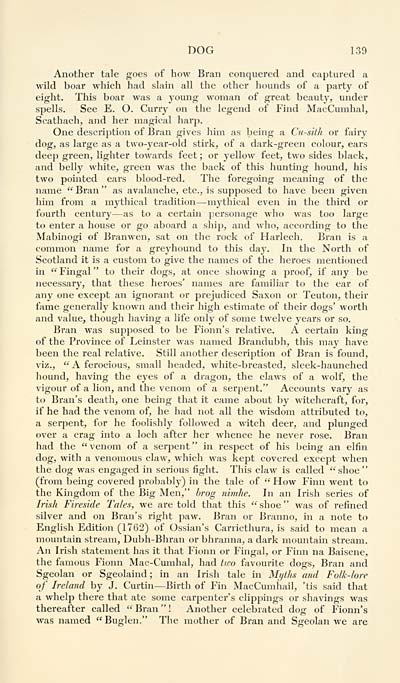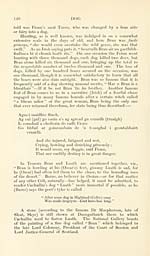Download files
Complete book:
Individual page:
Thumbnail gallery: Grid view | List view

DOG 139
Another tale goes of how Bran conquered and captured a
wild boar which had slain all the other hounds of a party of
eight. This boar was a young woman of great beauty, under
spells. See E. O. Curry on the legend of Find MacCumhal,
Scathach, and her magical harp.
One description of Bran gives liim as being a Cu-sith or fairy
dog, as large as a two-year-old stirk, of a dark-green colour, ears
deep green, lighter towards feet ; or j'ellow feet, two sides black,
and belly white, green was the back of this hunting hound, his
two pointed ears blood-red. The foregoing meaning of the
name " Bran " as avalanche, etc., is supposed to have been given
him from a mythical tradition — mythical even in the third or
fourth century — as to a certain personage who was too large
to enter a house or go aboard a ship, and who, according to the
Mabinogi of Branwen, sat on the rock of Harlech. Bran is a
common name for a greyhound to this day. In the North of
Scotland it is a custom to give the names of the heroes mentioned
in " Fingal " to tlieir dogs, at once showing a proof, if any be
)iecessary, that these heroes' names are familiar to the ear of
any one except an ignorant or prejudiced Saxon or Teuton, their
fame generally known and their high estimate of their dogs' worth
and value, though having a life only of some twelve years or so.
Bran was supposed to be Fionn's relative. A certain king
of the Province of Leinster was named Brandubh, this may have
been the real relative. Still another description of Bran is found,
viz., " A ferocious, small headed, white-breasted, sleek-haunched
hound, having the eyes of a dragon, the claws of a wolf, the
vigour of a lion, and the venom of a serpent." Accounts vary as
to Bran's death, one being that it came about by witchcraft, for,
if he had the venom of, he had not all the wisdom attributed to,
a serpent, for he foolishly followed a witch deer, and plunged
over a crag into a loch after her wOience he never rose. Bran
had the "venom of a serpent" in i-espect of his being an elfin
dog, with a venomous claw, which was kept covered except when
the dog was engaged in serious fight. This claw is called "shoe"
(from being covered probably) in the tale of " How Finn went to
the Kingdom of the Big Men," brog nimhe. In an Irish series of
Irish Fireside Tales, we are told that this " shoe " was of refined
silver and on Bran's right paw. Bran or Branno, in a note to
English Edition (1762) of Ossian's Carricthura, is said to mean a
mountain stream, Dubh-Bhran or bhranna, a dark mountain stream.
An Irish statement has it that Fionn or Fingal, or Finn na Baiscne,
the famous Fionn Mac-Cumhal, had two favourite dogs. Bran and
Sgeolan or Sgeolaind ; in an Irish tale in Mijths and Folk-lore
of Ireland by J. Curtin — Birth of Fin MacCumhail, 'tis said that
a whelp there that ate some carpenter's clippings or shavings was
thereafter called " Bran " ! Another celebrated dog of Fionn's
was named " Buglen." The mother of Bran and Sgeolan we are
Another tale goes of how Bran conquered and captured a
wild boar which had slain all the other hounds of a party of
eight. This boar was a young woman of great beauty, under
spells. See E. O. Curry on the legend of Find MacCumhal,
Scathach, and her magical harp.
One description of Bran gives liim as being a Cu-sith or fairy
dog, as large as a two-year-old stirk, of a dark-green colour, ears
deep green, lighter towards feet ; or j'ellow feet, two sides black,
and belly white, green was the back of this hunting hound, his
two pointed ears blood-red. The foregoing meaning of the
name " Bran " as avalanche, etc., is supposed to have been given
him from a mythical tradition — mythical even in the third or
fourth century — as to a certain personage who was too large
to enter a house or go aboard a ship, and who, according to the
Mabinogi of Branwen, sat on the rock of Harlech. Bran is a
common name for a greyhound to this day. In the North of
Scotland it is a custom to give the names of the heroes mentioned
in " Fingal " to tlieir dogs, at once showing a proof, if any be
)iecessary, that these heroes' names are familiar to the ear of
any one except an ignorant or prejudiced Saxon or Teuton, their
fame generally known and their high estimate of their dogs' worth
and value, though having a life only of some twelve years or so.
Bran was supposed to be Fionn's relative. A certain king
of the Province of Leinster was named Brandubh, this may have
been the real relative. Still another description of Bran is found,
viz., " A ferocious, small headed, white-breasted, sleek-haunched
hound, having the eyes of a dragon, the claws of a wolf, the
vigour of a lion, and the venom of a serpent." Accounts vary as
to Bran's death, one being that it came about by witchcraft, for,
if he had the venom of, he had not all the wisdom attributed to,
a serpent, for he foolishly followed a witch deer, and plunged
over a crag into a loch after her wOience he never rose. Bran
had the "venom of a serpent" in i-espect of his being an elfin
dog, with a venomous claw, which was kept covered except when
the dog was engaged in serious fight. This claw is called "shoe"
(from being covered probably) in the tale of " How Finn went to
the Kingdom of the Big Men," brog nimhe. In an Irish series of
Irish Fireside Tales, we are told that this " shoe " was of refined
silver and on Bran's right paw. Bran or Branno, in a note to
English Edition (1762) of Ossian's Carricthura, is said to mean a
mountain stream, Dubh-Bhran or bhranna, a dark mountain stream.
An Irish statement has it that Fionn or Fingal, or Finn na Baiscne,
the famous Fionn Mac-Cumhal, had two favourite dogs. Bran and
Sgeolan or Sgeolaind ; in an Irish tale in Mijths and Folk-lore
of Ireland by J. Curtin — Birth of Fin MacCumhail, 'tis said that
a whelp there that ate some carpenter's clippings or shavings was
thereafter called " Bran " ! Another celebrated dog of Fionn's
was named " Buglen." The mother of Bran and Sgeolan we are
Set display mode to: Large image | Transcription
Images and transcriptions on this page, including medium image downloads, may be used under the Creative Commons Attribution 4.0 International Licence unless otherwise stated. ![]()
| Early Gaelic Book Collections > Blair Collection > Gaelic names of beasts (mammalia), birds, fishes, insects, reptiles, etc > (165) |
|---|
| Permanent URL | https://digital.nls.uk/79331227 |
|---|
| Description | A selection of books from a collection of more than 500 titles, mostly on religious and literary topics. Also includes some material dealing with other Celtic languages and societies. Collection created towards the end of the 19th century by Lady Evelyn Stewart Murray. |
|---|
| Description | Selected items from five 'Special and Named Printed Collections'. Includes books in Gaelic and other Celtic languages, works about the Gaels, their languages, literature, culture and history. |
|---|

